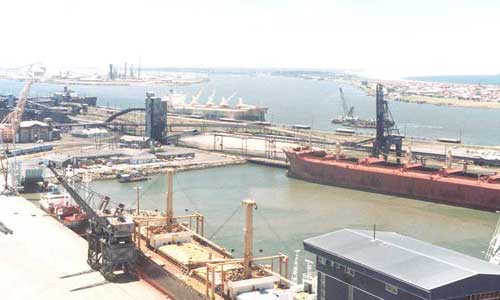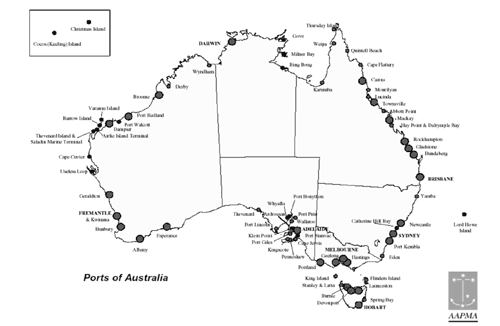Human-made capital located on estuaries has taken advantage of the function of these areas to provide for deep and sheltered anchorage as well as for natural beauty.
The port infrastructure and annual revenue

Photo 1. Newcastle harbour looking toward city from wheat silos. (photo by Colin Tindall)
An important use of estuaries is as ports for shipping, handling transport of exports and import, both from or to overseas and interstate sources or destinations, of much of the output from agriculture, manufacturing and mining sectors.
Ports are located around the Australian coastline with the largest sited close to the state capitals. Table 3 provides summary information about the estimated value of infrastructure, including property, plant and equipment held by a number of port authorities in Australia as well as the operating revenue of these authorities during the year 1999-2000.
| Port Authority | Operating Revenue ($m) | Property, Plant and Equipment ($m) |
|---|---|---|
| Sydney Port Authority | 107 | 485 |
| Melbourne Port Corporation | 77 | 535 |
| South Australian Port Authority | 38 | 85 |
| Fremantle Port Authority | >55 | 88 |
| Port Hedland | 12 | 162 |
| Port of Brisbane Corporation | 79 | 480 |
| Gladstone Port Authority | 86 | 294 |
| Hobart Ports Corporation | 16 | 52 |
| Darwin Port | 6 | 56 |
| Total | 476 | 2,237 |
Table 1. Value of infrastructure and operating revenue for a selection of Australian Ports, 1999-2000
Source: Annual Reports 1999/2000 Port Authorities, various

Figure 1. Ports of Australia
Not all of the ports in Australia are included in the table above. However, the information provides an indication of the value of investment in port infrastructure located on a number of estuaries around Australia.
Port Melbourne is the biggest port in Australia, with an investment of over $535m in property, plant and equipment. The port handles $50bn of trade annually for which it received payments totalling $77m in 2000 and is estimated to contribute $5bn per annum to the Victorian State economy in direct and flow-on benefit1.
The value of foreign trade handled at Queensland ports exceeds $14bn per annum with marine-based tourist activities estimated to be in excess of $5bn per annum. The Port of Brisbane Corporation has strived to establish the image of a “green port” and was the first port management in Australasia to receive ISO 14001 environmental accreditation. This accreditation is also held by the Fremantle Port Authority2.
Darwin Port is poised to become a major gateway to northern trade routes with the construction of the Adelaide to Darwin railway as well as the development of the Timor Sea gas fields. Currently, the port is not only responsible for marine industry and naval support, but also for tourism and recreational facilities2.
For the most part, a review of policy statements from the authorities managing these ports indicates that all of these ports are conscious of the need to improve their environmental image and use expressions such as “meeting the triple bottom line” for investment criteria as well as “community consultation” to develop future management plans2.
The value of the ports around Australia is substantial. Substitution of many of the services offered by shipping transport is not available so that these facilities can be regarded as being asset specific and as such provide a service to the Australian economy that is far beyond the value of infrastructure and annual revenue.
However, while substantial economic gains can be made from the presence of ports in estuarine areas, the ports themselves are potentially a source of environmental and economic hazard. One of the most obvious hazards in a port is the risk of shipping accidents3. The probability of these accidents occurring in ports is enhanced due to the high volume of shipping traffic and the potentially dramatic variations in water depths. In the event of an accident, toxic materials could be released into the waterway. These toxins could originate from the ship’s cargo, the ship’s fuel or indeed the ship’s paint. Other hazards that might surround the operation of a port include the release and introduction of marine pest invaders from incoming vessels and/or the creation of water turbidity and release of toxins from the sediments due to dredging. Dredging is often required to allow large ships into port. All of these hazards have the potential to result in large economic costs ranging from clean up bills, to lost production of the marine environment to lost aesthetic appeal of the affected areas. For more information on the risk of marine pest invasions associated with ports in Australia see4.
To conclude, it is apparent that estuarine environments can provide the basis from which extensive and economically important human capital can be created, in the form of ports. However, these positive gains can be counteracted by the marine hazards potentially introduced as a result of port activities. These potential hazards cannot be totally eliminated from the operation of the ports but it is important to invest in programs to minimise and manage these risks as much as possible given that the potential costs to arise from accidents have the potential to be enormous. More information on the potential economic consequences to arise from port activities can be found under the economic consequences of marine pest invasions.
Contributors
Robinson, J., Cully, T., Coastal CRC
- Melbourne Ports Corporation. 2001. http://www.melbport.com.au ↩
- Port Authorities, various. Annual reports 1999/2000 ↩ ↩ ↩
- the Department of Environment, Water, Heritage and the Arts. 2001. Activities and uses of the marine environment. ↩
- Harris, P. and P. O’Brien. 1998. Australian Ports Environmental Data & Risk Analysis Phase 1: Literature Review, A Report Prepared for Australian Quarantine Inspection Service (AQUIS), pp.201. ↩


